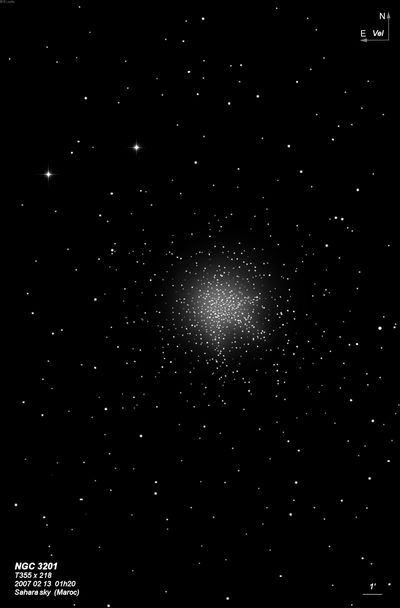
James Dunlop discovered NGC 3201 = D 445 = h3238 on 1 May 1826 with his 9-inch reflector at Parramatta, NSW, and described a "pretty large, pretty bright round nebula, 4' or 5' diameter, very gradually condensed towards the centre, easily resolved into stars; the figure is rather irregular, and the stars are considerably scattered on the south preceding side: the stars are also of slightly mixed magnitudes."
John Herschel first observed NGC 3201 on 20 Apr 1836 and recorded a "globular cluster, irregularly round, gbM, not v m comp, 6', resolved into stars 13...15th mag." On a second sweep he called it "irregularly round, 7' diameter, but the outliers extend to at least 10' or 12'; gpmbM, but not very much compressed; all resolved into stars 13..16th mag."
NGC 3201 is 7th in ranking of brightest member stars (mag 11.7) and 10th in ranking of horizontal-branch mag (mag 14.8). The distance is ~20,000 light years.
300/350mm - 13" (2/23/85): this fairly bright globular cluster appears fairly large and mottled. But only a few stars were resolved due to the view being compromised by the very low elevation (~5° altitude) from northern California.
400/500mm - 18" (7/8/02 - Magellan Observatory, Australia): beautifully resolved globular at 171x and 228x. The cluster is fairly large, ~8'-10' diameter with more careful viewing. Roughly 150 stars were resolved, though the number grew with magnification and averted vision. A fairly dense layer of brighter mag 11.5-12 stars were resolved right over the bright core. The halo, which has a large number of mag 13 stars, had a scraggly, irregular edge and seemed elongated - possibly partially obscured by dust. This concentration class X cluster is 7th in ranking of brightest stars (mag 11.7) and 10th in horizontal-branch mag stars (mag 14.8).
600/800mm - 24" (4/11/08 - Magellan Observatory, Australia): at 200x, this beautiful, loose globular was well resolved with approximately two hundred mag 12 to 16 stars visible within a 10' region. An unusual feature is the large number of brighter cluster stars that appear to be superimposed right on top of a fainter layer of stars in the central core. The core seemed displaced towards the north side as if part of the northern half of the cluster was obscured and flattened. This apparent affect may also be due to a larger number of brighter resolved stars that are superimposed on the northern half of the core. A number of stars in the outer halo are arranged in strings and chains and the outer extent of the halo is irregular.
Notes by Steve Gottlieb